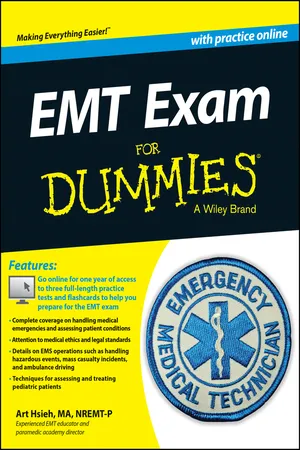
- English
- ePUB (mobile friendly)
- Available on iOS & Android
EMT Exam For Dummies with Online Practice
About this book
Test-taking strategies and steps to succeed as an EMT
No two EMT exam experiences are exactly alike, as questions are tailored to the test-taker and range in topics from handling medical emergencies and patient assessment, to medical ethics, ambulance operations, and pediatrics. EMT Exam For Dummies takes the intimidation out of the test, offering everything you need to prepare for—and pass—the exam. Along with the book, there is also an online companion website that features two additional practice tests that you do your best on test day.
Career opportunities are abundant for certified EMTs, and this straightforward guide increases your chances of scoring higher on the computer-adaptive and practical portions of the exam so you can get out in the field and dispense lifesaving medical care. In the book, you'll find an overview of the EMT Exam, including test organization and how the exam is scored, content review with practice questions, a sneak peek at the practical exam, and one full-length practice test with detailed answer explanations.
- Includes sample test questions and detailed answers throughout, as well as a sneak peek into the practical test
- Gives you two bonus practice exams via the companion online test bank, with tests available in timed and untimed formats
- Offers clear test-taking advice for passing the crucial, practical part of the exam
- Covers the psychomotor component of the EMT Exam
EMT Exam For Dummies has everything you need to succeed as an EMT and continue your training, and with an easy-to-read style and focus on the most important details, you'll be ready to pass the exam in no time!
Frequently asked questions
- Essential is ideal for learners and professionals who enjoy exploring a wide range of subjects. Access the Essential Library with 800,000+ trusted titles and best-sellers across business, personal growth, and the humanities. Includes unlimited reading time and Standard Read Aloud voice.
- Complete: Perfect for advanced learners and researchers needing full, unrestricted access. Unlock 1.4M+ books across hundreds of subjects, including academic and specialized titles. The Complete Plan also includes advanced features like Premium Read Aloud and Research Assistant.
Please note we cannot support devices running on iOS 13 and Android 7 or earlier. Learn more about using the app.
Information
Making Sense of the EMT Exam

- Discover what an emergency medical technician (EMT) does and where an EMT works. (Essentially, an EMT provides basic emergency care, such as oxygen administration, spinal immobilization, and splinting; EMTs typically work in ambulances, but they’re also deployed as part of wilderness and search and rescue teams.)
- Read about the education you need to certify as an EMT. Not only is there the textbook information to acquire, but there are skills to master as well as time you’ll spend with actual patients while you’re in training.
- Get the scoop on the National Registry of Emergency Medical Technicians (NREMT) exam. You may have heard that the exam is really hard. There’s a reason for that, but it’s not what you think!
Becoming an Emergency Medical Technician



Understanding What Being an EMT Means
What does an EMT do?
- Emergency medical responder (EMR): 48–60 hours of training. An EMR provides minimum, basic first aid. Lifeguards, police officers, and some firefighters are often required to have this certification.
- Emergency medical technician (EMT): 120–180 hours of training. This level serves as the foundation for higher certification levels. An EMT provides basic emergency care, such as oxygen administration, spinal immobilization, and splinting. Many states require this certification as a minimum to work as a staff member on an emergency ambulance. Many firefighters and police officers also earn EMT certification so that they can perform basic emergency care as part of their duties.
- Advanced emergency medical technician (AEMT): 160–300 hours of training beyond EMT. This training can vary quite widely from one state to the next. In addition to the skill set of the EMT, AEMTs may perform intravenous therapy, administer a limited set of medications, and manage a patient’s airway at a higher level than an EMT.
- Paramedic: 1,100 hours or more of training beyond EMT. In addition to the skill set of the AEMT, the paramedic receives more information about human anatomy and physiology, the pathophysiology of disease, and trauma, and can administer a greater array of emergency medications. Paramedics can insert endotracheal tubes to help patients breathe and perform various types of electrical therapy to help heart rhythm disturbances.
Where do EMTs work?
Can you use EMT training for other purposes?
Walking through the Steps of Becoming an EMT
Finding and completing a class
Table of contents
- Cover
- Title Page
- Table of Contents
- Introduction
- Part I: Making Sense of the EMT Exam
- Part II: Test-Taking Tips and Strategies
- Part III: Assessing What You Know and Reviewing Essential Information
- Part IV: Putting Your Knowledge into Practice
- Part V: The Part of Tens
- About the Author
- Cheat Sheet
- More Dummies Products
- End User License Agreement

